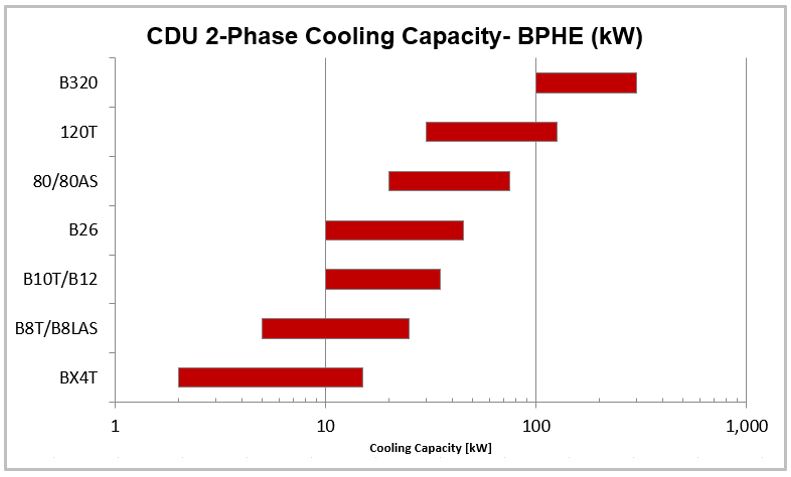Des solutions de refroidissement optimisées dans un format compact
Dans le monde effréné du stockage des données informatiques, un refroidissement et des solutions de récupération d'énergie efficaces sont essentiels. Les BPHE de SWEP excellent dans la fourniture de solutions compactes, mais extrêmement efficaces.
Applications utilisant les échangeurs thermiques pour le refroidissement des "datacenters"

Économisez de l'énergie et de la place avec des solutions pour le refroidissement libre
Pas de compromis avec l'efficacité énergétique!
Découvrez les Top Tips et les solutions avant-gardistes de SWEP pour les gestionnaires énergétiques des centres informatiques.
Des unités de refroidissement pour le refroidissement de datacenters
Unités de refroidissement liquide pour les datacenters
La zone blanche des datacenters représente un coût important et l'optimisation de l'espace est indispensable. La technologie de plaques brasées de SWEP permet de créer des unités compactes de refroidissement par rangée ou par rack d'une capacité de refroidissement inégalée. De plus, nos échangeurs thermiques à double flux permettent de presque doubler les performances thermiques, pour un même encombrement, tout en minimisant l'espace de conception nécessaire.
La gamme de BPHE de SWEP pour une utilisation avec des fluides biphasés est sans équivalent. Les unités de refroidissement à fluide de condensation doivent être sélectionnées avec précision, en fonction des besoins de votre application. Ces BPHE sont facilement simulés dans notre logiciel de sélection SSP, sur la base de tests réels, ce qui garantit des performances optimisées et fiables pour les conditions de votre système.

SWEP propose une gamme complète d'échangeurs thermiques conçus pour les systèmes d'unités de refroidissement par liquide.
- Plages de capacité du refroidissement liquide basées sur l'eau ou le propylène glycol (30 %)
- Température d’entrée de l’eau à 25 °C (77 °F)
- Température d’entrée du propylène glycol (30 %) à 55 °C (131 °F)
- Pour de plus amples informations ou une aide pour la sélection, veuillez contacter SWEP.

SWEP propose une gamme complète d'échangeurs thermiques conçus pour les systèmes d'unités de refroidissement diphasique
- Refroidissement diphasé basé sur une plage de température d'entrée du réfrigérant de 16-20 °C (61-68 °F)
- Unités disponibles en version condenseur et cascade
- Pour de plus amples informations ou une aide pour la sélection, veuillez contacter SWEP.

Refroidissement mécaniqueSolutions optimisées pour les groupes froidsLa large gamme d'évaporateurs à BPHE de SWEP pour refroidisseurs combine une technologie innovante de plaques et de diffusion permettant de maximiser la capacité et l'efficacité. Nous travaillons avec tous les principaux fluides frigorigènes et de nombreux fluides peu courants, ainsi qu'avec les fluides A2L et A3, ce qui fait de nous le partenaire idéal pour les groupes froids de datacenters. La technologie de BPHE est également parfaitement adaptée aux applications telles que les condenseurs, les économiseurs et la récupération de chaleur avec la technologie à simple ou double paroi. |
 |
SWEP propose des évaporateurs avec des systèmes de diffusion qui sont optimisés pour une large gamme de réfrigérants et d'applications.
Les graphiques ci-dessous donnent une indication de l'évaporateur SWEP approprié en fonction de la capacité du système de refroidissement pour le R134a et le R410A.
 |
 |
Trane : Atteindre et dépasser les directives d'écoconception de jusqu'à 20 % grâce aux BPHE de SWEP
Le DFX650 True Dual de SWEP aide le principal fabricant de systèmes de chauffage, ventilation et climatisation (HVAC), Trane, à atteindre et à dépasser les directives d’écoconception autour du SEER (coefficient d'efficacité énergétique saisonnier) jusqu’à 20 % et à réduire la consommation d’énergie de ses clients.
La directive sur l’écoconception touche tous les types d’industries en fixant des normes minimales d’efficacité énergétique pour les groupes froid à air et les pompes à chaleur, entre autres. On estime que cette politique permettra aux Européens d’économiser en moyenne 490 euros par an sur leurs factures d’énergie.


Refroidissement libre/Économiseurs
Efficacité de refroidissement économisant l'énergie
Il est possible d'économiser de l'énergie si l'air ambiant ou une autre source froide peut être utilisé pour refroidir le rack de serveurs lorsque le refroidisseur est éteint, en utilisant le refroidissement libre (« free cooling »). Notre technologie de BPHE est idéale pour être utilisée comme circuit intermédiaire pour séparer la boucle de glycol externe de la boucle de serveur interne grâce à son efficacité thermique élevée de forme compacte.
La gamme de produits SWEP comprend le plus grand BPHE au monde avec des ports de 6" capables de traiter 1500 GPM (340 m3/h) par unité. La petite taille des BPHE permettra également une installation modulaire, garantissant la fiabilité pour une efficacité accrue à charge partielle et une redondance rentable.
La capacité des BPHE de SWEP s'étend bien au-delà du mégawatt, offrant une redondance compacte et rentable.
 |
- Plages de capacité du refroidissement libre basées sur l’eau ou l’éthylène glycol (30 %)
- Température d’entrée de l’eau de 16 °C (61 °F)
- Température d’entrée de l’éthylène glycol (30 %) de 13 °C (55 °F)
- Pour de plus amples informations ou une aide pour la sélection, veuillez contacter SWEP.
Refroidissement efficace des datacenters d'Infosys
Les grands datacenters ont besoin de solutions de refroidissement très performantes. Infosys Technologies Ltd, une société informatique de premier plan dont le siège est à Bangalore, en Inde, souhaitait disposer de plusieurs solutions rentables et très efficaces. Le responsable de la conception de projets, Schneider, a opté pour les échangeurs thermiques à plaques brasées (BPHE) de SWEP en raison de leur haute efficacité énergétique et de leur assistance technique fiable.
Le BPHE de SWEP est utilisé pour isoler la source primaire et secondaire, la source primaire d'eau provenant d'une tour de refroidissement. La source secondaire, dans laquelle l'eau devait être introduite, est constituée de serpentins de refroidissement alimentant du matériel informatique essentiel.

Ce client s'engage pour le développement des technologies de contrôle environnemental de précision appliquées dans de grands datacenters et autres domaines essentiels pour l’activité.
La solution SWEP avec (2) BPHE modèle B427 installés a permis une solution redondante beaucoup plus petite que ce que le client avait initialement prévu.
Lire l’intégralité de l'étude de cas ici




